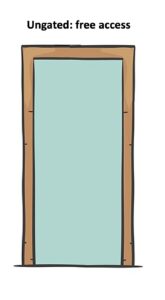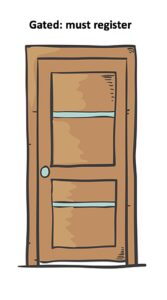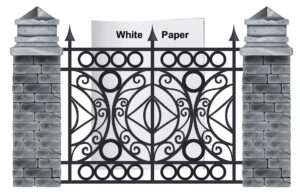
Gating: There is a third option
Most discussions about whether or not to gate content are all or nothing.
But did you know there’s a third option?
You can think of this as a “middle way” or a hybrid.
And it works very well for many companies, including my own.
In an earlier post of this series, I discussed the best practices for gated vs. ungated content.
The bottom line: If you want to generate leads, use a gate. If you just want to get noticed, take down the gate.
But sometimes it isn’t quite that simple. Sometimes we want to do a little of both.
If so, you may want to consider the middle way: Give away your basic content, but ask readers to register for more detailed or premium content.
Give away your basic content with no gate

This includes your blogs, infographics, or listicles (“5 Ways to Save on Mobility”).
Never gate case studies. These are powerful word-of-mouth references that you want to spread as far and wide as possible.
As these ungated items spread across the web, you can work to get comments and mentions on social media to build buzz about your company.
The more work you put in on that side the more downloads, likes, retweets, and shares you will see.
But much of this will happen beyond your viewpoint. You won’t get much information on where your content goes, or who has shared it.
Gate your premium content

When you invest heavily in a piece of content, think twice before you give it away.
After all, don’t you have to justify part of your marketing budget by generating leads to pass to Sales?
For example, don’t ungate an ambitious white paper that explains a confusing new trend in your industry.
Don’t ungate the results of your annual survey that will have everyone talking for weeks.
Don’t ungate an online assessment that reports how a visitor’s company compares with its peers.
To build even more value, perhaps bundle that with a free consultation to discuss where firms can improve their operations.
For top-quality content, set up a gate. You will get fewer downloads, but you’ll have contact info to act on for every person who accesses it.
A middle way: Lead prospects from ungated to gated

You can use a series of content pieces to coax your prospects to a deeper level of engagement.
At the end of a less ambitious piece, insert an offer for a more ambitious piece and give your readers an easy gate to step through.
There’s an even more subtle way to do this: Show visitors the start of a longer piece like a white paper, perhaps the executive summary and contents pages.
You can reveal that much right on the web in HTML, no download required.
At the end of that much, insert your gate. Anyone who starts reading and wants to find out more will register at that point.
And a prospect like that is golden: They’re already engaged with your content so odds are they’ll carry on reading.
Don’t ask for the moon… just a prospect’s name, work e-mail, company name, and perhaps zipcode.
Never ask for their mailing address, unless you plan to mail them something.
This hybrid approach works for me
My business runs on a much smaller scale than those of my clients, but it’s still a B2B service.
And this middle way has worked very well for me.
I have more than 150 articles on every aspect of white papers on this site (www.thatwhitepaperguy.com) all available free to visitors with no registration.
Visitors can also find two sample chapters plus links to half a dozen bonus articles related to my definitive book, White Papers For Dummies.
More ambitious content, such as my 15-page “ice cream” report on picking the perfect flavor for your next white paper stayed for years behind a registration form.
After a few years, I moved it out from behind the gate so anyone can access it.
I wanted the idea of the three flavors to spread. The last time I checked, this piece had been downloaded close to 10,000 times.
I’m now working on a set of checklists I believe will be valuable enough to gate.
And my monthly newsletter requires registration so I know where to send it.
This site’s registration form is simple, just four simple questions: first name, last name, e-mail, and the person’s role in their organization.
All this content makes Google smile
Due to all the useful and findable content here, www.thatwhitepaperguy.com is listed on the first page of Google search results for my chosen keywords.
This listing brings in leads for more projects than I can handle.
Plus, asking those simple questions before I hand over my gated content has generated a mailing list of thousands of names, segmented into two basic groups:
- B2B marketers
- White paper writers
This hybrid approach has worked well for my small business.
There’s no reason why it won’t work for a much larger organization as well.
Remember: search engine spiders can’t access your gated content. They get stopped at your registration page.
That means your best material may not be indexed and may remain unfindable by your best prospects.
So you don’t have to get locked into a binary, gated/approach.
For best results, consider how to build your content into campaigns, with ungated leading to gated materials.
What do you think of this approach? Are you using something similar? How is it working for you? Please tell me about it in the comments section below.
Originally published: October 14, 2014
Last updated: May 15, 2022
Want to hear whenever there’s a fresh article on this site? Subscribe here to stay in the know on long-form content. From time to time, we’ll also send you word about some great new resource or training. And you can unsubscribe any time.






Great point, Gordon. It’s not either/or. Sometimes an additional option (a fourth way?) is to have a different kind of gate. Rather than asking people for an email address, ask people to share the content on Twitter or their social media networks in exchange for access to it. Someone who’s not willing (yet) to give you an email address may be willing to share it instead, and that can help spread your ideas.